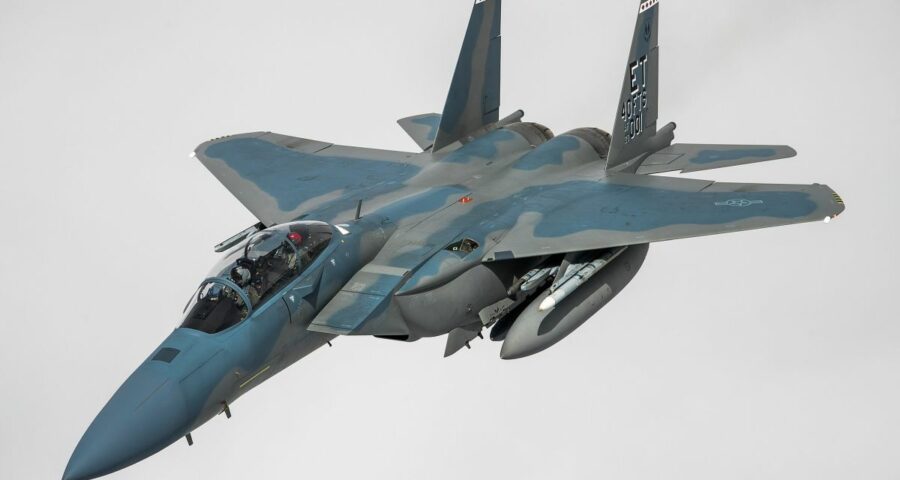The latest avatar of the F-15 is designed to deal with the world’s most potent air threats that are emerging from China.
The Indian Air Force, which is acquiring 114 multi-role combat aircraft (MRCA) from the global market, will relish the option of buying the highly capable F-15EX Eagle-II, developed and built by The Boeing Company.
The Eagle-II is the world’s fastest (Mach 2.5, or 3,100 kilometres per hour) and most heavily-armed (payload of 13.6 tonnes, or 30,000 pounds) fighter, with the longest strike range (1,200 nautical miles or 2,222 kilometres).
It has scored 104 kills in air-to-air combat without suffering a single loss.
Boeing has obtained a mandatory licence from the US government for discussing an F-15 sale with India.
Pratyush Kumar, until recently Boeing’s chief in India, now heads the F-15 Eagle-II programme in the US.
During his tenure in New Delhi, Kumar was associated with the induction of multiple Boeing platforms into India’s military, including the P-8I Poseidon maritime aircraft, the C-17 Globemaster III heavy-lift transporter, the Apache AH-64E attack helicopter and the Chinook CH-47F heavy-lift chopper.
When Kumar was transferred to Boeing’s F-15 programme in St Louis, USA, his golden touch logged up the United States air force’s (USAF’s) purchase of 144 F-15EX Eagle-IIs.
These will replace the venerable F-15C, which has, for decades, been the USAF’s primary air dominance fighter.
Last year, the USAF took delivery of its first game-changing Eagle-IIs, while Qatar received its first F-15QA Ababil fighters.
Boeing also contracted with Japan to upgrade the Japan Air Self-Defence Force’s legacy F-15J fighters to the F-15 Japan Super Interceptor (F-15JSI).
The club of existing F-15EX operators includes the US, Israel, Japan, Singapore, South Korea and, most recently, Qatar.
Kumar describes the F-15 Eagle-II as “the ideal high-end fighter for the high-end fight”.
This latest avatar of the F-15 is designed to deal with the world’s most potent air threats that are emerging from China.
These threats include hypersonic, re-targetable, long-range missiles; and advanced ‘early warning and control’ (AW&C) aircraft that can observe low-flying fighters at longer ranges.
To deal with these threats, Boeing is equipping the Eagle-II with faster missiles that have longer ranges, faster processors for radars, better data-link capabilities and that can take more weapons into the fight.
Kumar says the F-15EX will be continuously upgraded, since it has adequate physical space, computing infrastructure, structural strength and engine power.
The Eagle-II will be competing in the Indian MRCA tender against seven other types of combat aircraft.
Of these, six were offered to the IAF by six original equipment manufacturers (OEMs) in response to a 2007 tender for 126 fighters (six squadrons).
That tender — the world’s biggest at the time — fizzled out into a much smaller purchase of 36 Rafale fighters.
Now, with the IAF initiating a fresh acquisition of 114 fighters (six squadrons) in 2019, improved variants of those six fighters have re-entered the fray.
Besides the earlier six, another two fighters have thrown their hats into the ring for the current tender, which is likely to be even bigger at $15 billion-$20 billion.
In 2007, the IAF was offered four twin-engine aircraft: Boeing’s F/A-18E/F Super Hornet; Dassault’s Rafale, Eurofighter GmbH’s Typhoon, and Russia’s RAC MiG-35.
In addition, two single-engine aircraft were fielded: Lockheed Martin’s F-16 Super Viper; and Swedish firm, Saab’s Gripen E/F.
The new tender, initiated in 2019, is likely to see two more big, twin-engine fighters competing: The F-15EX Eagle-II and Russia’s Sukhoi-35.
Boeing faces a difficult choice over which fighter to offer in the MRCA tender: The Eagle-II or the Super Hornet.
“Offering the F-15EX would result in Boeing pulling out the Super Hornet from the MRCA contest,” says a senior company official.
However, Boeing is extremely confident in its offer of the Super Hornet for the Indian Navy’s tender of 57 “twin-engine deck-based fighters” (TEDBF).
However, with uncertainty over the prospect of a second indigenous aircraft carrier (IAC-2) in the navy, the 57-TEDBF competition seems to be morphing into the purchase of a smaller number of jets.
The MRCA’s specifications are not yet out, so Boeing is uncertain about whether the Eagle-II or the Super Hornet would be a better fit for the IAF.
“India needs to relook at their force structure in the light of Rafale and Tejas orders,” says the Boeing official. “If the gap is at the high performance end, the F-15EX could be a fit. But these are early days.”
Feature Presentation: Aslam Hunani/Rediff.com
Source: Read Full Article


